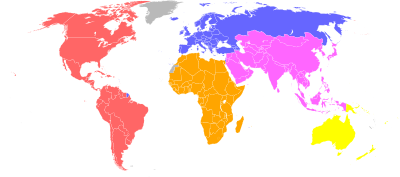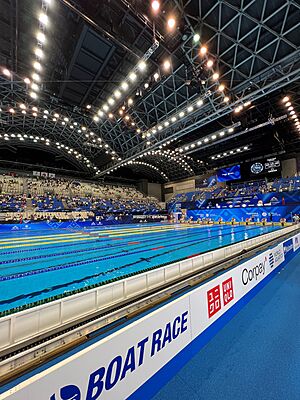World Aquatics facts for kids
 |
|
| Sport |
|
|---|---|
| Jurisdiction | International |
| Abbreviation | AQUA |
| Founded | 19 July 1908 in London, United Kingdom |
| Affiliation | Association of Summer Olympic International Federations (ASOIF) |
| Headquarters | Lausanne, Switzerland |
| President | Husain Al-Musallam |
| Replaced | International Swimming Federation |
| Official website | |
World Aquatics is the main organization that manages international water sports competitions. It used to be called FINA, which stood for "Fédération internationale de natation" (International Swimming Federation). This organization is recognized by the International Olympic Committee (IOC).
World Aquatics is based in Lausanne, Switzerland. It makes sure that competitions in water sports follow fair rules around the world.
The organization was first created as FINA in 1908. It officially changed its name to World Aquatics in January 2023.
World Aquatics currently looks after six main water sports:
- Swimming
- Diving
- High diving
- Artistic swimming
- Water polo
- Open water swimming
They also organize "Masters" competitions for adults in these sports.
Contents
History of World Aquatics
FINA was started on July 19, 1908, in London, England. This happened at the end of the 1908 Summer Olympics. Eight countries helped create FINA: Belgium, Denmark, Finland, France, Germany, Great Britain, Hungary, and Sweden.
In 1973, the first World Aquatics Championships took place in Belgrade, Yugoslavia. This event included swimming, water polo, diving, and synchronized swimming.
The first permanent FINA office opened in Lausanne, Switzerland, in 1986.
Open water swimming became part of the World Aquatics Championships in 1991.
In 1993, the first World Aquatics Swimming Championships (25m) was held in Spain. This event uses a shorter 25-meter pool.
High diving was added to the World Aquatics Championships in 2013.
In 2015, World Aquatics held its main championships and the FINA World Masters Championships (for older athletes) together for the first time in Kazan, Russia.
World Aquatics celebrated 110 years in 2018 by opening a new main office in Lausanne, Switzerland.
On December 12, 2022, the organization voted to change its name to World Aquatics. This decision was made in Melbourne, Australia.
In July 2023, World Aquatics decided to move its main office to Budapest, Hungary. Budapest has hosted the championships several times. An interim office opened in Budapest in November 2024, with a full move planned by 2027.
Here's how many national federations have joined over the years:
- 1908: 8
- 1928: 38
- 1958: 75
- 1978: 106
- 1988: 109
- 2000: 174
- 2008: 197
- 2010: 202
- 2012: 203
- 2015: 208
- 2016: 207
- 2017: 209
- 2023: 208
Members of World Aquatics
World Aquatics has many member countries, called national federations. In June 2017, Bhutan became the 208th member. Anguilla joined later in November 2017, becoming the 209th member.
Sometimes, countries might be removed from the list or have their athletes compete under special rules. For example, athletes from the Philippines competed as 'Neutral Independent Athletes' in September 2023. Athletes from Kenya currently compete as 'Suspended Member Federation'. Athletes from Russia and Belarus are not allowed to compete, but their countries are still listed as members. World Aquatics also allows athletes who don't belong to a member country to compete as part of an 'Athlete Refugee Team'.
Members are grouped by continent. There are five continental associations they can join:
- Africa (52 members): Africa Aquatics
- Americas (45 members): PanAm Aquatics
- Asia (44 members): Asia Aquatics
- Europe (52 members): European Aquatics
- Oceania (15 members): Oceania Aquatics
Note: The number next to each continent shows how many World Aquatics members are in that area. It's not always the exact number of members in the continental association.
How World Aquatics is Organized
World Aquatics has a new set of rules, approved in December 2022. These rules explain how the organization is run. The main groups that manage World Aquatics are:
- The Congress
- The Bureau
- The Executive
- The Aquatics Integrity Unit
- The Athletes Committee
- The Technical Committees
- The Specialised Committees
The World Aquatics Congress is the highest decision-making body. It can decide on any matter for World Aquatics. A Congress meeting happens every two years, usually during the World Championships.
The World Aquatics Bureau includes the President and 39 other members. These members are chosen from different continents and include representatives from the Athletes Committee.
Various other committees help manage specific sports, like the Technical Open Water Swimming Committee. They also handle topics like anti-doping.
Current Leaders
| Office | Officeholder | Country |
|---|---|---|
| President | Husain Al-Musallam | Kuwait |
| First Vice President | Sam Ramsamy | South Africa |
| Second Vice President | Matthew Dunn | Australia |
| Treasurer | Dale Neuburger | United States |
| Vice President | Juan Carlos Orihuela | Paraguay |
| António Silva | Portugal | |
| Zhou Jihong | China | |
| Executive Director | Brent Nowicki | United States |
Presidents of World Aquatics
Each president serves for four years. Their term starts and ends in the year after the Summer Olympics.
| FINA/World Aquatics presidents | ||
|---|---|---|
| Name | Country | Term |
| George Hearn | 1908–1924 | |
| Erik Bergvall | 1924–1928 | |
| Émile-Georges Drigny | 1928–1932 | |
| Walther Binner | 1932–1936 | |
| Harold Fern | 1936–1948 | |
| Rene de Raeve | 1948–1952 | |
| M.L. Negri | 1952–1956 | |
| Jan de Vries | 1956–1960 | |
| Max Ritter | 1960–1964 | |
| William Berge Phillips | 1964–1968 | |
| Javier Ostos Mora | 1968–1972 | |
| Harold Henning | 1972–1976 | |
| Javier Ostos Mora (2nd term) | 1976–1980 | |
| Ante Lambaša | 1980–1984 | |
| Robert Helmick | 1984–1988 | |
| Mustapha Larfaoui | 1988–2009 | |
| Julio Maglione | 2009–2021 | |
| Husain Al-Musallam | 2021–present | |
Major Competitions
World Aquatics Championships
The biggest event organized by World Aquatics is the World Aquatics Championships. This competition happens every two years, usually in odd-numbered years. All six water sports are part of this event. Swimming races use a 50-meter pool.
The World Open Water Swimming Championships are part of the main championships. There were also separate Open Water Championships held in even years from 2000 to 2010.
The World Masters Championships are for athletes aged 25 and older (30+ for water polo). This event has been held alongside the main World Aquatics Championships since 2015. Before that, it was a separate event every two years.
Due to the COVID-19 pandemic, the championships were held every year from 2022 to 2025. They will return to being held every two years from 2025 onwards.
Other Sport Competitions
World Aquatics also organizes separate tournaments and series for individual sports. These include competitions for younger athletes.
World Tournaments for Each Sport
- Swimming: World Swimming Championships (25m), also known as 'Short Course Worlds'. This event happens every two years in even years and uses a 25-meter pool.
- Water polo: Men's and Women's Water Polo World Cup.
- Diving: Diving World Cup (every two years).
- High diving: High Diving World Cup (every year).
World Series for Each Sport
- Swimming: Swimming World Cup (every year, usually in a 25-meter pool).
- Diving: Diving World Series (every year).
- Artistic swimming: Artistic Swimming World Cup (every year).
- Open water swimming: Marathon Swim World Series (every year).
Junior Championships
These are world-level championships for younger athletes. The age limit changes depending on the sport and gender.
- Swimming: World Junior Swimming Championships (every two years).
- Water polo: Junior, Youth and Cadet Water Polo World Championships (every two years).
- Diving: World Junior Diving Championships (every two years).
- Artistic swimming: World Junior Artistic Swimming Championships (every two years).
- Open water swimming: World Junior Open Water Swimming Championships (every two years).
Sport Name Changes
In 2017, FINA officially changed the name of synchronised swimming to Artistic Swimming. This was done to show that the sport now judges not just how well swimmers move together, but also their choreography and artistic expression.
Rules and Bans
World Aquatics has rules about athletes who break anti-doping rules. Even if an athlete has stopped competing, they can still face suspensions.
Rules for Russia and Belarus
Athletes and officials from Russia and Belarus were not allowed to participate in World Aquatics events through the end of 2022. World Aquatics also canceled events that were planned to be held in Russia. In March 2022, after the 2022 Russian invasion of Ukraine, World Aquatics banned all Russians and Belarusians from competing at the 2022 World Aquatics Championships. They also moved the 2022 FINA World Swimming Championships (25 m) from Russia.
Before this, World Aquatics had already banned athletes from these countries from wearing their national colors, using their country's name, or having their national anthem played if they won. Also, times set by Russian swimmers in non-World Aquatics competitions from April to December 2022 did not count for world rankings or records.
On September 4, 2023, World Aquatics announced new rules. These rules allow some Russian and Belarusian athletes to compete as 'Neutral Independent Athletes' under strict conditions.
More to Explore
- History of competitive swimwear
- FINA Athletes of the Year
- World Aquatics Day
- International Swimming Hall of Fame (ISHOF)
- List of swimming competitions
- List of international sport federations
- Major achievements in swimming by nation
See also
 In Spanish: World Aquatics para niños
In Spanish: World Aquatics para niños




